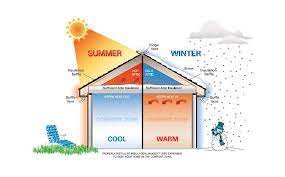Importance of Proper
Proper insulation is not just about staying warm in the winter; it’s a fundamental aspect of maintaining a comfortable, energy-efficient home. In this article, we’ll delve into the various facets of home insulation, exploring its impact on energy efficiency, comfort, and even the environment.
Energy Efficiency
Impact on Heating and Cooling Costs
The primary function of insulation is to regulate the temperature inside your home. By creating a barrier against external temperatures, insulation significantly reduces the need for constant heating or cooling. This, in turn, translates to lower energy bills and a more sustainable lifestyle.
Environmental Benefits
Beyond cost savings, efficient insulation contributes to environmental conservation. Reduced energy consumption means fewer greenhouse gas emissions, aligning your home with eco-friendly practices.
Comfort and Indoor Air Quality
Temperature Regulation
Proper insulation ensures that your home maintains a consistent temperature, eliminating uncomfortable cold spots. It also prevents excess heat from infiltrating during warmer months, creating a more enjoyable living environment year-round.
Moisture Control
Insulation acts as a barrier against moisture, preventing issues like mold and mildew. This not only protects your home’s structural integrity but also contributes to better indoor air quality.
Types of Insulation Materials
Fiberglass
One of the most common insulation materials, fiberglass is known for its cost-effectiveness and versatility. It’s an excellent choice for various areas within your home.
Foam Board Ideal for insulating walls, foam board provides excellent thermal resistance and can be easily cut to fit specific spaces.
Cellulose
Made from recycled paper, cellulose insulation is an eco-friendly option known for its effectiveness in attics and walls.
Signs of Inadequate Insulation
High Energy Bills
If your energy bills have been skyrocketing, it could be a sign that your home lacks proper insulation. Insufficient insulation forces your heating and cooling systems to work harder, consuming more energy.
Uneven Temperature Distribution
Do you notice significant temperature differences between rooms? Inadequate insulation might be causing heat to escape or infiltrate unevenly.
Drafts and Cold Spots
Feeling chilly drafts or encountering cold spots in your home are clear indicators that your insulation may need attention.
DIY Insulation Tips
Seal Gaps and Cracks
A cost-effective way to improve insulation is by sealing gaps and cracks around windows, doors, and other openings. This prevents unwanted air exchange.
Install Weather Stripping
Weather stripping around doors and windows is a simple yet effective DIY solution to reduce heat loss and gain.
Upgrade Attic Insulation A well-insulated attic is crucial for overall energy efficiency. Consider upgrading insulation in this area to maximize its impact on your home’s comfort.
Professional Insulation Services
Assessment and Recommendations
Professional insulation services often begin with a thorough assessment of your home. Experts can identify areas with inadequate insulation and recommend suitable solutions.
Installation Process
Hiring professionals ensures proper installation, addressing specific needs for different parts of your home. This guarantees optimal insulation performance.
Return on Investment
Long-Term Savings
While investing in quality insulation may seem like an upfront cost, the long-term savings in energy bills make it a financially sound decision.
Increased Property Value
A well-insulated home is an attractive feature for potential buyers, increasing the overall value of your property.
Eco-Friendly Insulation Options
Recycled Materials
Opting for insulation made from recycled materials contributes to sustainability and reduces the environmental impact of new production.
Sustainable Practices
Some insulation providers follow sustainable manufacturing processes, further reducing their carbon footprint.
Common Insulation Myths
“All Insulation Is the Same”
Different areas of your home may require different types of insulation based on factors like temperature, moisture, and space constraints.
“New Homes Don’t Need Insulation”
Even new homes can benefit from additional insulation, as construction standards may not always prioritize energy efficiency.
“Insulation Is Only for Cold Climates”
Insulation is essential in both cold and warm climates, helping regulate temperatures year-round.
Importance of Proper Installation
Avoiding Common Mistakes
Improper installation can negate the benefits of insulation. Ensuring a professional and precise installation is key to maximizing its effectiveness.
Ensuring Maximum Effectiveness
Properly installed insulation provides a consistent barrier against external elements, ensuring your home remains comfortable and energy efficient.
Government Incentives and Rebates
Encouraging Energy-Efficient Upgrades
Many governments offer incentives and rebates to encourage homeowners to invest in energy-efficient upgrades, including insulation.
Maintaining Insulation Over Time
Regular Checks and Upkeep
Periodically checking your insulation for wear and tear allows you to address issues before they impact your home’s efficiency.
Addressing Wear and Tear
If you notice any signs of damage or degradation, prompt repairs or replacements can maintain the integrity of your insulation.
Conclusion
The importance of proper insulation in your home cannot be overstated. It goes beyond mere comfort, impacting your energy bills, environmental footprint, and even the overall value of your property. Whether through DIY efforts or professional services, investing in quality insulation is a step toward a more sustainable and comfortable living space.
Frequently Asked Questions (FAQs)
- What is the recommended R-value for insulation?
The recommended R-value depends on factors like climate and location. It’s advisable to consult with a professional for personalized recommendations.
- Can I install insulation myself, or should I hire a professional?
While some DIY efforts can improve insulation, certain areas and materials are best handled by professionals to ensure optimal performance.
- How often should insulation be replaced?
Insulation typically lasts for several decades, but it’s essential to monitor its condition and consider replacement if signs of wear and tear appear.
- Are there any health concerns related to certain insulation materials?
Most modern insulation materials pose no significant health risks when installed correctly. Always follow safety guidelines during installation.
- What government incentives are available for home insulation?
Government incentives vary by location. Check with local authorities for information on available rebates and programs.





